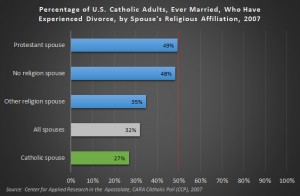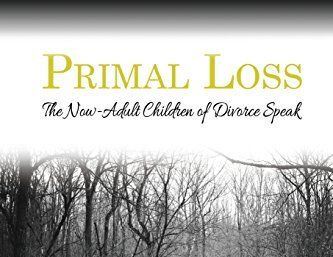 It would seem that figuring the divorce rate would be a rather simple thing. But like most sociological phenomena, there are many complicating factors (especially today when even simple definitions are breaking down). But however you measure divorce, it would seem that practicing Catholics fare far finer than any other group, believer or non-believer.
It would seem that figuring the divorce rate would be a rather simple thing. But like most sociological phenomena, there are many complicating factors (especially today when even simple definitions are breaking down). But however you measure divorce, it would seem that practicing Catholics fare far finer than any other group, believer or non-believer.
I recently read a CARA (Center for Applied Research in the Apostolate) study and would like to share a few thoughts from it. The fuller commentary by Mark Gray is over at the CARA blog here: Divorce Still Less Likely Among Catholics
First, the question arises as to how best to measure the divorce “rate.” There have been several methods used over the years, some of which have lost accuracy since fewer and fewer people are ever getting married in the first place. Hence, some problems have arisen in referencing traditional divorce measures:
Problem 1 – The “Crude rate” numbers have become skewed. The “crude rate” is the total number of divorces in a year per 1,000 of the population. But the problem with this number is that the number and percentage of Americans who are married has dropped significantly in the past thirty years. In the 1970s nearly three-quarters of the adult population was married. In 2012, only 52% of U.S. adults were married. Quite a remarkable drop that we have commented on before on this blog.
And thus, the crude marriage rate in 2011 was 6.8 new marriages per 1,000 of the U.S. population. And the number of divorces that same year were 3.6 per 1,000 of the U.S. population (so the “divorce rate” using this statistic was that 53% marriages failed).
Note however, in the 1980s this measure peaked above 5 per 1,000. Now this makes it seem that the divorce rate has dropped (from 5 to 3.6). But that is illusive since the number of Americans getting married at all has dropped dramatically. Which such a dramatic social shift, the “crude divorce rate” provides only a snapshot in time, but is no longer very helpful in comparing to previous decades.
Problem 2 – The Divorce rate or “percentage” compares two unrelated numbers. Thus to use the 2011 data from above, we see that the divorce rate was 53%. But that is a rather inaccurate way of putting it, since the number of marriages and divorces in any single year are for the most part unrelated. It is rare that people marry and divorce in the same year.
Thus, the divorces in any given year are accumulated from marriages that took place any and varied number of years ago in the past. Thus, one number (the divorces filed in 2011) is an accumulated number and the other number, (the number of marriages in 2011), is data for just one year.
To say that “half of all marriages in 2011 failed” does not actually address the reality of 2011, but a rather complex series of years in the past, that also includes some recent and dramatic sociological shifts that are difficult to factor in.
This does not mean that the 53% number has no meaning, only that its meaning is a little more complicated that is usually reported.
Problem 3 – Simply Counting Divorces is ambiguous – This is for the reasons stated. Namely that so many never get married in the first place today or, get married quite a bit later in life. Without marriage you won’t ever end up in the divorce statistics. And so, simply counting how many have divorced is becoming a less meaningful number since it less often means that they have thereby been and successfully stayed married.
Thus, another common number, the number of Americans who have ever divorced, is becoming an increasingly meaningless number. It can provide a snap shot for the year, but what does in mean to say that XX% of Americans have been affected by divorce when the overall percentage of Americans ever getting married is plummeting? And even if some of those Americans are simply postponing marriage by some ten to twenty years, that still has a profound effect on how numbers can or should be interpreted.
For the record however, the percentages in 2010 of Americans who had ever been divorced are these[1]:
1. Americans in General: 26%
2. Protestants 31%
3. Other religious Affiliation 26%
4. No religious affiliation 24%
5. Catholics 20%
Thus, using this number Catholics are less likely divorce. But does this number possibly reflect other trends too, such that that Catholics are less likely to enter Holy Matrimony in the first place? It is difficult to say. We Do put more delaying tactics in place for couples that approach us for Matrimony, is that a factor? Does it have an effect on the number of Catholics not marrying or delaying marriage?
So what is the best metric to gauge the divorce rate? Mark Gray at CARA offers that the most meaningful statistic measures the percentage of Americans who have ever married that experience a divorce. It is still just a snapshot, and does not fully exclude those who have divorced more than once, but it does provide the most helpful view of something close to the “odds of divorce.”
If this be the case, here too, Catholics rank quite well. Here are the percentages of those who have ever been married who have experienced a divorce [2]:
1. Americans in general: 36%
2. No religious affiliation 42%
2. Protestants 39%
4. Other religious Affiliation 35%
5. Catholics 28%
So again, Catholics fare better in this second and probably most helpful divorce statistic.
There is one other statistic worth considering within the Catholic number, that further erodes the divorce rate for a Catholic. And that is that when a Catholic enters Matrimony with a Catholic, the divorce likelihood is far less than if a Catholic marries out side the faith.
 Note the Chart from the CARA Study at left.
Note the Chart from the CARA Study at left.
As will be noted, divorce is almost twice as likely when a Catholic marries a Protestant or non-believing person instead of a Catholic.
As a pastor, I notice a real difference, although my “data” is anecdotal, when the Catholic enters Matrimony with a Protestant who is devout. Frankly, in most mixed marriages I celebrate, the Protestant is not devout or even practicing their faith to any real degree. However, in the cases where they are, I must say, the situation is often quite difficult the notions that love will simply conquer all is a conclusion that lacks sobriety for the most part.
As a general norm and experience, when a Catholic who is reasonably devout, marries a Protestant who is likewise devout, my experience tells me that there is trouble and pain ahead. I have less experience with Muslims, but the data is similar.
That said, I have also experienced that many mixed marriages (where intense devotion by the non-Catholic is not an overriding factor) are rich sources of converts. I have even seen happily, some Muslims come to the Catholic faith on account of their believing spouse.
So, bottom line, the Faith matters! Practicing Catholics, especially those who enter Matrimony with a practicing Catholic, have significantly lower divorce rates. Of course it makes sense doesn’t it? The faith lived seeks God’s help, the power of the Sacraments, is rooted in God’s Word and teaching, insists on forgiveness as one of the highest virtues, and calls for regular self-examination in the Sacrament of Confession. Those who root their life in God are going to be more rooted themselves in the commitments they make.
The divorce rate, even among practicing Catholics is still to high. But, the solution of faith remains a strong remedy and a healing help.
 The Heineken Beer holiday commercial below “taps” into a sad reality for many families: divorce and “remarriage.”
The Heineken Beer holiday commercial below “taps” into a sad reality for many families: divorce and “remarriage.”




